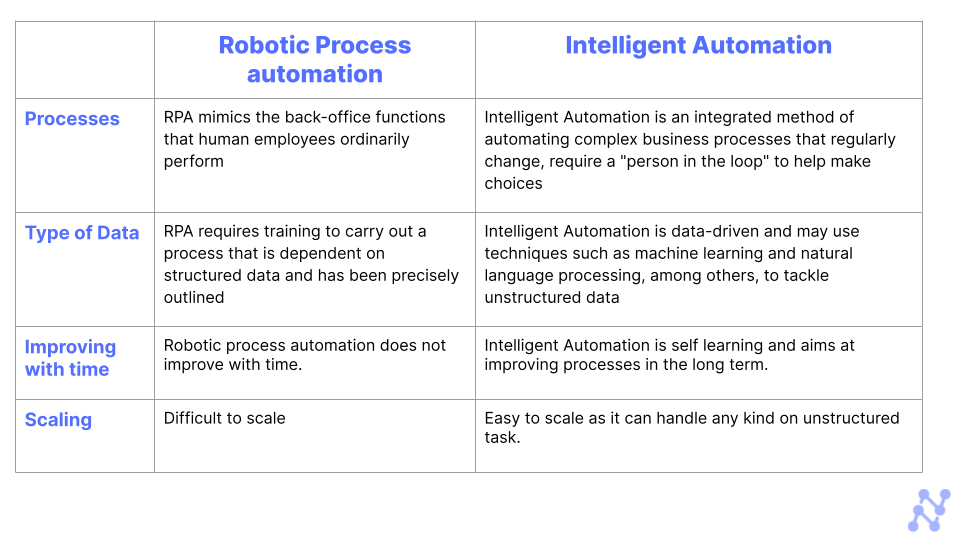
Looking for an intelligent automation solution? Look no further! Try Nanonets Intelligent Automation Platform to automate manual tasks. Used by 10k+ users and 500+ enterprises. No Credit Card is required.
To automate a system, a company must implement a method that allows it to run without human intervention. A wide range of industries, including information technology (IT), manufacturing, and transportation, use automation services. This decade is likely to see rapid advancements in intelligent automation software. Robotic process automation is among the top technology used by organizations to implement intelligent automation.

As a response, staff may now focus on more creative endeavors thanks to advancements in robotic process automation and intelligent automation technology. Using RPA and IA, organizations have improved customer satisfaction and employee morale without sacrificing operating expenses, despite the challenges they faced. Even though RPA and IA are closely linked, this article will explain everything about Intelligent Automation Vs RPA and more essential terms about them. Let's get started!
What is Robotic Process Automation?
Technology that imitates human actions to execute rule-based activities is known as robotic process automation (RPA). You may optimize and speed up your business processes by using robots to complete defined activities. You can use the software to standardize any operation that requires structured data as inputs, as it will do the same duties every time. Primarily, recurrent, uninterrupted, and clearly defined processes can be automated using robotic process automation. Because it can handle time-consuming and low-level tasks like logging into programs, copying data, scraping data, and linking to APIs.
Robotic Process Automation (RPA) is one of the breakthrough technologies that the latter half of the last century has experienced. Its growth and broad acceptance have radically altered how businesses conduct their operations. It is a technology and method that uses specialized computer programs known as software bots to automate monotonous, regulation, high-volume, and repeating operations previously performed by people.
The rewards of RPA adoption are enormous. Using RPA, human workers can focus on high-value jobs while RPA does low-value tasks. For example, suppose a report requires the efforts of a human employee and takes five hours to complete. Improve your employees' productivity by completing a task in 30 minutes or less with RPA.
Additionally, organizations benefit from higher productivity as a result of RPA. Employees are only human, and they are prone to making mistakes. Correcting those errors, on the other hand, can be quite expensive. This potential is obviated via RPA. Because bots are so precise, there is less room for human error as you increase the amount of manual work you delegate to them. Additionally, your firm may efficiently collect data from several sources and consolidate it in a single location for analytical reasons by utilizing RPA technologies.
Read more about RPA :
Want to scrape data from PDF documents, convert PDF to XML or automate table extraction? Check out Nanonets' PDF scraper or PDF parser to convert PDFs to database entries! Check out OCR API, Invoice automation, Passport OCR, AP Automation Solution, Receipt OCR, and License OCR Solution, or start your free trial by clicking below!
What is meant by Intelligent Process Automation?
Robotic Process Automation (RPA) is the muscle of automation, while IA is the brain. The former is in charge of executing things, while the latter is in charge of thinking about things properly. The evolution of RPA into IA can be summarized this way: Machine learning (ML), natural language processing (NLP), and artificial intelligence (AI) are used to optimize the entire business process rather than just individual jobs in RPA. As a result, IA is capable of acquiring knowledge, thinking, and making decisions.
Cognitive Automation, machine learning, business process automation (BPA), and robotic process automation (RPA) are all examples of IA, which combines AI and automation technology. As a result, processes are streamlined with the help of IA. Because of this simplicity, the user can focus on the end result rather than the process needed to achieve it or the borders between applications.
Using intelligent tools, such as virtual assistants and chatbots, enables enterprises to gain valuable insights that improve automation efficiency and speed up customer response times. Optical character recognition (OCR) is an example of a tool that can help paper-intensive businesses, such as healthcare or financial services, make better decisions by automating text analysis.
There are numerous uses of Intelligent Automation. For example, Intelligent Automation is being used to power chatbot assistants, which are already commonplace on many websites. Finance teams can also use it to undertake advanced analytics, such as tax forecasting, which can be done with incredible accuracy. Further, it may assist in various ways, including product optimization, inventory management, logistics planning, and more.
Looking for Intelligent Automation & RPA Solution? Download our expert guide to buying RPA Software.
What makes up Robotic Process Automation?
It is now possible to automate time-consuming tasks and accomplish business objectives more effectively thanks to new technology such as robotic process automation. The use of software robots can allow enterprises to run their current processes more quickly and correctly, around the clock, without sacrificing quality. Increased scalability, improved operational precision, enhanced compliance, and cost savings are just a few of the benefits that can be realized.
Whenever a new employee joins a company, RPA transforms various business scenarios, such as the onboarding process. Typically, IT administrators have to enter and copy data from one platform to another in order to update employee information in many systems.
Consider, for example, HR managers who generate job offer letters and onboard new hires in accordance with predetermined procedures. These are just a few of the many clerical jobs employees are expected to execute daily. Organizations can free up personnel from these labor-intensive manual operations by implementing robotic process automation, allowing them to concentrate their skills on more operational planning that can propel the company forward.
Want to automate repetitive manual tasks? Check our Nanonets workflow-based document processing software. Extract data from invoices, identity cards, or any document on autopilot!
What makes up Intelligent Automation?
Robotic process automation (RPA) has traditionally been used to automate front- and back-office functions, but the incorporation of AI and ML in IPA platforms allows them to go much further. Because of AI, IPA platforms can now analyze semi-structured and unstructured data for cognitive technologies like natural language processing (NLP), intent detection, and more. Users can use this to create sophisticated workflows for chatbots and other customer service applications.
Instead of automating operations that already exist with RPA tools, IPA solutions enable users to develop new processes by re-imagining old ones, optimizing them using deep learning, or incorporating cutting-edge technologies like intelligent decisions. In addition, it is possible to optimize operations in real time and in the future using machine learning algorithms that examine historical and real-time data. Automated workflow routing, for example, can be used to automatically fix faulty workflows based on their expected run times, log contents, or flow control. Even so, the IPA is more than just process design and optimization.
Robotic Process Automation Examples
We have compiled examples of how RPA has helped companies cut costs, save time, remain competitive, and produce better work.
Accounting & Financial Management (Invoice Processing)
There are a lot of tiresome and error-prone accounting and financial management activities, yet they're critical to a company's success. That's why RPA is an excellent fit for many of those functions. There are many time-consuming tasks within Accounts Payable, such as invoice processing. There are various ways in which invoices are received, matched to purchase orders, and then approved for payment.
With RPA, invoices are sent automatically, so your employees may focus on outliers while the rules are being created to send the correct people invoices for approval. The PO matching procedure can also be automated to mark any problems for further inspection before the payment is submitted.
Human resources (Hiring & Onboarding)
It might take weeks and be expensive to hire only one worker. Fortunately, RPA can help with many of the repetitive and rules-based processes involved in the hiring and onboarding process. For example, a bot can search for candidates 24 hours a day, 365 days a year. This bot might also screen resumes and candidates after sourcing applicants.
For instance, when a company wants to hire a worker, a bot might handle much of the "paperwork" to complete and submit multiple employment applications.
Retail (Inventory Management)
There are a lot of labor-intensive tasks in retail that are ideal for Automation. Even more so, as enterprises react to e-commerce trends, retailers, in particular, should look into RPA solutions for inventory management, which can benefit greatly. Many shops have to keep track of various products in different regions.
To guarantee that they have an excellent product to meet demand and obtain insight into their demand and other market trends, companies need inventory management.
RPA can address these concerns by automating several processes:
For example, low-inventory alerts can be sent out automatically (or even automated ordering). Improving the efficiency of inventory management to maximize working capital while still meeting demand. In order to reduce inventory errors, 60% of the time, inventory records are erroneous. Assessing sales figures both domestically and abroad.
Payroll Automation
Every HR team has to handle payroll processing every month, which is a tedious and time-consuming operation. It's common for rework to be required due to the volume of work, which might lead to payment delays. Employees don't like it when their wages are delayed! An RPA bot can verify employee data across different systems, including timesheets, earnings, and tax deductions. Taxable perks and other reimbursements can be handled through RPA as well.
Customer Service
Customers today demand immediate responses and the ability to get their inquiries to the correct people. RPA is a great fit for customer assistance since many issues and queries can be resolved, standardized and repeatable.
Further, technical assistance, billing, sales, and other functions can all be handled with RPA. And another excellent example is chatbots, even if they fall under the purview of both RPA and AI.
Want to use robotic process automation? Check out Nanonets workflow-based document processing software. No code. No hassle platform.
Business Process Examples Using Intelligent Automation Solutions
We have compiled examples of how Intelligent Automation Solutions has helped companies cut costs, save time, remain competitive, and produce better work.
Financial Services
Numerous operations within the financial services industry are prime candidates for intelligent process automation due to the requirement to shorten the amount of time it takes to respond to customers' inquiries and remain in compliance with stringent laws.
Consider paper-based or form-based procedures, such as loan applications, credit decisions, and claims processing, where information can be collected and swift choices based on pre-defined standards.
IPA ensures that each stage of a process is carried out, ensuring that workers have access to the information they require to perform their jobs effectively and that consumers are supplied more practically.
Government Sector
Government service organizations have a high priority on improving client service and employee morale, yet relying on manual processes and old systems can have a negative impact on both. Passports, driving licenses, birth, death, and marriage certificates are all examples of processes that can benefit from IPA, which reduces the burden on employees and improves constituent service.
On the other hand, IPA can be employed to improve the effectiveness of crisis responses. For example, IPA can help your personnel work more swiftly to restore normality during disaster management crises by providing precise, real-time data.
Manufacturing
The primary motivating factors behind the rise of Automation in manufacturing are efficiency gains, improvements in product quality, and cost reductions. You can ensure that all of your paperwork is stored in a single digital location if you automate the supply chain administration.
This cuts down on the amount of manual input, which saves time and reduces human errors. Additionally, by adopting a method known as a "smart factory," you may integrate all of the components of your production procedure, enabling you to be more responsive to your customers' requirements.
In addition to facilitating collaboration and accelerating approval procedures, IPA may even assist you in bringing forward-thinking goods to market in a more reasonable manner. This is made possible by the clarity that process mapping and Automation bring to the table.
Healthcare
Medical personnel sometimes do excessive data entry into dozens of mandatory apps. Performing data entry and repeating efforts in a second app takes time away from giving treatment. One IT leader reported her organization had over 4000 separate apps supported and maintained for different medical and business activities. Intelligent Automation alleviates duplicate data entry by eliminating the requirement to transfer the data.
If you work with invoices, and receipts or worry about ID verification, check out Nanonets online OCR or PDF text extractor to extract text from PDF documents for free. Click below to learn more about Nanonets Enterprise Automation Solution.
Intelligent Automation vs. RPA: What’s the difference between Intelligent Automation vs. RPA?

Artificial intelligence (AI) and robotic process automation (RPA) can easily be mistaken because they both perform jobs and imitate human abilities. However, the contrasts become more apparent when considering one as the brain and the other as the body.
Relying on automation technology, RPA mimics the back-office functions that human employees ordinarily perform. Automating complicated business processes using AI (Artificial Intelligence), machine learning, and natural language processing is intelligent Automation.
Unlike RPA, Intelligent Automation is used when RPA is no longer feasible. Intelligent Automation is an integrated method of automating complex business processes that regularly change, require a "person in the loop" to help make choices, or adopt and successfully implement machine learning and artificial intelligence while RPA performs laborious and repetitive activities.
Further, Robotic Process Automation aims to complete a process successfully, which is sometimes referred to as being process-centric. The RPA tools handle specific, rule-based, and repetitive activities.
RPA requires training to carry out a process that is dependent on structured data and has been precisely outlined. On the other hand, IPA is data-driven and may use techniques such as machine learning and natural language processing, among others, to tackle unstructured data. Through algorithms, the system can teach itself to recognize data coming and take swift action depending on what's required to do.
Want to automate repetitive manual tasks? Save Time, Effort & Money while enhancing efficiency!
What are the benefits of Intelligent Automation vs. RPA?
Follow the below benefits of Automation.
Improve Operational Efficiency
One of the advantages of Automation is unlocked by simply adopting automation software. You get to audit and fine-tune your processes since you set up the processes and rules you want the software to complete. As a result, you'll be able to spot any inefficient or malfunctioning processes. Improved operational efficiency is the net outcome of this change in strategy. In addition, you can enhance the effectiveness of critical procedures within your organization.
Reduce costs
Cost-cutting is another benefit of automating business processes. Software never gets old or runs out of resources. As a result, you can accomplish more with fewer resources.
Rapid reactions
Another advantage of Automation is the ability to respond quickly when necessary. For example, incoming data can be parsed by business process automation software, including emails, web forms, social media, system data, etc. Afterward, it might notify you of issues such as customer complaints or service interruptions.
Reduce Errors
Human errors can occur when data is entered manually. For example, Automation can take on manual data entry chores on your behalf, reducing the chance of human error. This ensures that your data entry is of consistently high quality.
FAQs
Is RPA more complex than Intelligent Automation?
Virtual machines have taken the place of humans in numerous businesses. RPA may be implemented quickly and cost-effectively. AI can be more complicated, including massive networks of software robots exchanging information with one other, but RPA is still a more straightforward solution. It takes time and effort to set up and run an AI system.
What is the use of intelligent Automation?
End-to-end computerized business operations are the goal of intelligent Automation. Employees benefit from it because it helps them produce faster, safer, and more cost-effective services while working with them in tandem. This has a positive impact on both the customer and the employee experience.
What is intelligent automation?
The term "intelligent automation" refers to a solution for Automation augmented with cognitive skills that provide computer programs with the ability to learn, comprehend, and respond to their environments.
Read more about Robotic Process Automation on Nanonets
Nanonets online OCR & OCR API have many interesting use cases that could optimize your business performance, save costs and boost growth. Find out how Nanonets' use cases can apply to your product.



